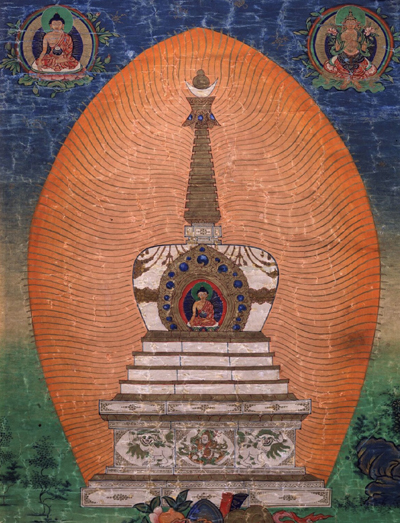Katokpa Jangchub Bumpa
Katokpa Jangchub Bumpa (kaH thog pa byang chub ‘bum pa) was born in a place called Tramtri (khram khri) in 1284, the wood-monkey year of the fifth sexagenary cycle. His father, the Tramtripon Gyelpo (khram khri dpon rgyal po), was the ruler of the region. Details of his childhood and youth are not known; he was said to be an uncommon child in many ways, with innate realization and recollection of his previous lives.
His father, the Tramtripon Gyelpo (khram khri dpon rgyal po), was the ruler of the region. Details of his childhood and youth are not known; he was said to be an uncommon child in many ways, with innate realization and recollection of his previous lives.
At the age of forty-four, in 1327, the fire-hare year of the sixth sexagenary cycle, Jangchub Bumpa succeeded Yeshe Bumpa (ye shes ‘bum pa, 1242-1328) as the sixth abbot and the sixth lineage holder of Katok Monastery. Initially he focused on the monastery’s traditional teachings and practice of Tantra, mainly the Guhyagarbha Tantra, the main tantra of the Mahāyoga class and the primary Tantric text studied in the Nyingma tradition. He is said to have built one hundred eight temples in Tromgi Yetse Sumdo (khrom gyi ye tshe sum mdo), the river valley that includes Katok. Chinese artisans (rgya bzo) were employed in the construction of the sacred objects and also imported many religious objects from China.
Jangchub Bumpa was recognized as having a high level of realization and tantric ability. According to legend, during the construction of the temples laborers suffered from severe starvation. Some enemies of his exploited the situation to try to humiliate him. They brought about a thousand sheep in front of Yeshe Bumpaand said, “Your people do not have food to survive. Would it be all right to kill and eat these sheep?” He replied, “Yes! It is of course all right to do so”. He instructed them to wrap the bones in their skins after killing the sheep and distribute the meat. After this was done, Yeshe Bumpa snapped his fingers and from the skin-wrapped bones rose up and began moving about, fully living sheep. He then snapped his fingers a second time and the revitalized sheep were transformed into rays of light that vanished in space.
It was said that Jangchub Bumpa later trained a number of disciples in Bartro (bar khrod), Yangtro (yang khrod), and Dampuk (dam phug) who were capable of transforming their physical forms into light through their power and experience in tantric practice. The practice of Guhyagarbha and Dzogchen are said to have been at their peak during his era. Among his devotees were Pelberwa Namkha Dorje (dpal ‘bar ba nam mkha’ rdo rje, d.u.) and Dorje Pel (rdo rje dpal, d.u.). Disciples are said to have established Katok branch monasteries in Mon (mon) and Kongpo (kong po) regions.
Jangchub Bumpa passed into nirvana in 1347, the fire-pig year of the sixth sexagenary cycle at the age of sixty-four. Being one of the three famous Bumpa lamas of Katok Monastery, his reliquary was installed with the founder and his two immediate disciples in Kumbum (sku ‘bum). He was succeeded by his discipleSonam Zangpo (bsod nams bzang po, 1295-1357) as the seventh abbot.
Source: The Treasury of lives
Leave a Reply